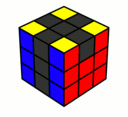| Roux Method | |
|---|---|
 ' | |
|
Proposer(s): |
Gilles Roux |
|
Proposed: |
2003 |
|
Alt Names: |
N/A |
|
Variants: |
N/A |
|
No. Steps: |
4 |
|
No. Algs: |
9 - 42 |
|
Avg. Moves: |
~45 |
|
Purpose(s): |
|
The Roux Method (French pronunciation: [ʁu]) is a 3x3 speedsolving method invented by Gilles Roux. Unlike the Fridrich and Petrus methods, the inventor of this method has used it to achieve an official sub-15 average. Similarities can be drawn to the Petrus method's block building and the Waterman method's layer-on-the-left and edges-last aspects.
The Steps[]
1. Build a 1x2x3 block anywhere on the cube.
2. Build a second 1x2x3 block opposite of the first 1x2x3 block, without disrupting the first 1x2x3 block. After this step, there should be two 1x2x3 blocks: one on the lower left side, and one lower right side, leaving the U slice and M slice free to move.
3. Simultaneously orient and permute the remaining 4 corners on the top layer (U-slice). This can be done by using CMLL, COLL, or Corner OLL's (along with the T and Y permutation).
4a. Orient the 6 remaining edges using only M and U moves (UF, UB, UL, UR, DF, DB need to be oriented correctly).
4b. Solve the UL and UR edges, preserving edge orientation. After this step, both the left and right side layers should be complete.
4c. Solve the centers and edges in the M slice.
Pros[]
Like the Petrus method, the Roux method uses fewer moves than the popular Fridrich method. It is also more intuitive and requires fewer algorithms. After the first block is built the rest of the cube can be solved mostly with R, r, M and U moves thus eliminating rotations.
Cons[]
Block building can be difficult for a beginner to get used to. The reliance on r and M moves may also be difficult for some people, so much so that cubers who have trouble with M turns should probably not use this as their main method if they are not willing to put forth the effort to perfect M moves. Its heavy reliance on M moves would make it a poor method for one-handed solving. Slice turns can also be slower than using a quarter-turn metric.
Improvement[]
Some Roux users have learned multiple algorithms for each CLL case, each affecting edges in a different way. This allows for manipulation of edge orientation, leading to an easier LSE.
Possibly another improvement is to expand to solving any of the four second blocks. This means that the D-layer colors of the two blocks don't have to match. One negative, if someone has already learned a recognition method for CLL, is that to easily use the full range of second block options, a switch to NMCLL recognition is necessary. Another is that LSE EO is a bit more difficult to recognize in some solves.
